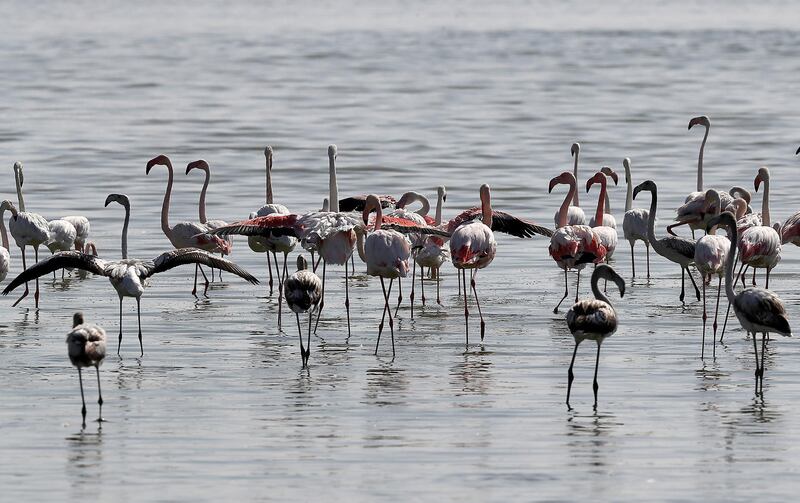The recently concluded Conference of the Parties to the Ramsar Convention on Wetlands, held in Dubai, provided a welcome focus on one of the most endangered types of habitat in the world. Wetlands − whether inland rivers and lakes, coastal marshes and mudflats or offshore islands and their surrounding waters − are important not just for wildlife and plants, but also for the way in which they contribute to the global ecosystem and, therefore, to the quality of human life.
The Convention, established in 1971, seeks to protect key areas from the damaging impact of modern development. That's of particular significance here in the Emirates. Not only do we have no permanent rivers, low rainfall and an arid climate, but the rapid pace of development means that many of our natural wetlands have succumbed to the onward march of land reclamation, construction and associated factors.
Around the world, there are now more than 2,200 designated Ramsar Sites, eight of which are in the UAE. These include marine and island sites, such as Sharjah's Sir Bu Nair island and the Bul Syayeef complex of islets, mangroves and lagoons west of Abu Dhabi, as well as coastal creeks like Dubai's Ras Al Khor and Ajman's Al Zorah. Inland, the Al Wathba Wetland Reserve and the Wadi Wurayah National Park in Fujairah's mountains provide more diversity, both of habitat and of the species of flora and fauna to be found within them.
Each has its own particular significance. Wadi Wurayah is the home for several of our rarest mammals and birds, including the crested porcupine and the spotted eagle-owl. Al Wathba and Bul Syayeef host the only breeding colonies of greater flamingoes in Arabia. Khor Kalba in Sharjah has breeding turtles and the only known site for one of our rarest lizards and is home to nearly all of the world's population of a sub-species of the white-collared kingfisher. The recently recognised Jebel Ali Wetland Sanctuary in Dubai provides a home for more than 500 marine species, including the endangered mottled eagle ray, the Indo-Pacific humpback dolphin, endangered green turtles and vulnerable dugongs.
All of these sites are now protected for the future, even if, as is the case with Ras Al Khor and Al Zorah, the wetlands are much smaller now than they used to be.
We can, and should, celebrate the conservation of these areas.
Much of the UAE’s wetlands, however, particularly in coastal areas, have now been irretrievably lost, with a consequent negative impact on the country’s biodiversity and on areas of the natural environment which were once available for non-invasive leisure pursuits. Yas Island, little more than sandbanks and shallow waters a decade ago, is a prime example. Khor Al Beida in Umm Al Quwain is a wetlands complex of unquestioned significance, with important and endangered bird species, that has already been adversely affected by development. Protection of at least key parts of it is long overdue.
Many of the entries on a preliminary list of important UAE wetland sites that I and some colleagues compiled nearly a quarter of a century ago would no longer qualify.
Looking to the future, though, there are still areas that retain much of their natural value and are worthy of consideration as further UAE Ramsar Sites. They include some of the private islands around Abu Dhabi City, whose owners have carefully kept development to a minimum. They deserve credit for that.
Preservation of our wetlands, though, isn’t simply a matter of protecting the natural environment. Al Wathba Wetland Reserve, now managed by the Environment Agency – Abu Dhabi, is one of the nation’s most important Ramsar sites. When I first visited it, nearly 30 years ago, it was an area of sabkha, or salt flat, which occasionally flooded after heavy rains. Now, thanks to the building of the Abu Dhabi-Al Ain truck road and the carefully controlled discharge of treated effluent from the nearby Mafraq waste water treatment plant, the site is of regional importance for its bird populations, not just flamingoes, but much else besides.
With a bit of imagination, other such sites can be established. Dubai’s Al Qudra Lakes are wholly man-made. They have rapidly attracted resident and migrant birds, and have become a popular destination for Dubai residents seeking an escape from the big city at weekends. An innovative use of the waste water generated in Abu Dhabi’s inland oilfields could quickly lead to the creation of new and similarly important wetlands. That can be done while, at the same time, we preserve the most important of our natural ones.
The benefits are not simply for avid birdwatchers, like me, but for the broader community, in terms of leisure opportunities and of the promotion of environmental awareness.
There are other advantages, too. I can understand why, for some city-dwellers, the expanse of shallow waterways, sandbanks and mangroves either side of the Sheikh Khalifa Highway, between Saadiyat and Yas, might appear boring and of little value. In fact, such natural wetland areas help to protect against storm damage and erosion. At a time when climate change and rising sea levels threaten the vast majority of the UAE’s population who live close to the coast, that should, surely, be of vital concern to those who plan the future of our country.





